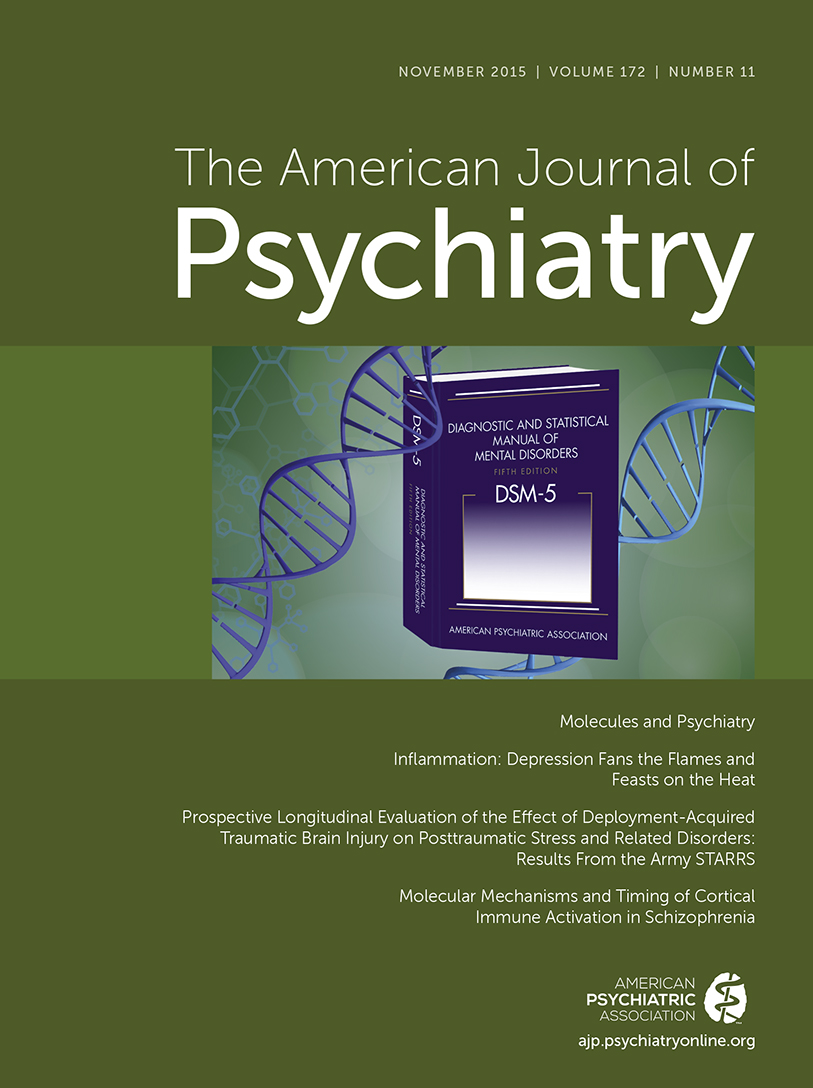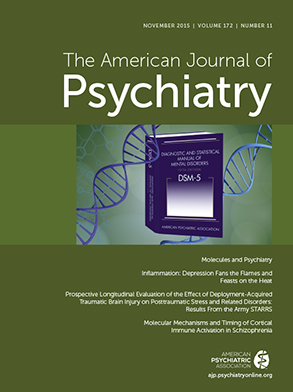A core pathology in schizophrenia is the imbalance in inhibition and excitation in cortical circuits related to alterations in the inhibitory neurotransmitter γ-aminobutyric acid (GABA) and the excitatory neurotransmitter glutamate, resulting in suboptimal synchronization of neural circuits needed for cognitive function (
1). Postmortem studies have provided definitive evidence for abnormal GABA-related parameters in schizophrenia, which are thought to reflect deficits in GABA transmission, either as a primary or a secondary adjustment to alterations in glutamate. MR spectroscopy (MRS) measurements have provided discrepant results, indicating the possible effects of antipsychotic medications, as well as age, illness phase, and use of anticonvulsants, on measurements of GABA (
2). One limitation of this literature is the absence of in vivo measures of GABA transmission in the vicinity of the synapse, which can only be provided by molecular positron emission tomography (PET) imaging. The ambitious study that Frankle and colleagues report in this issue (
3) is an important first step in addressing this deficiency.
Frankle et al. combined a few technical maneuvers to obtain their novel measure of in vivo perisynaptic GABA tone. They used PET radiotracer imaging of the benzodiazepine site on the ionotropic GABA
A receptor, with the radiotracer [
11C]flumazenil, which binds to all alpha subunit-containing GABA
A receptors, thus targeting synaptic as well as extrasynaptic sites corresponding to the location of these GABA
A receptors (
4). They combined imaging with a pharmacological challenge using tiagabine, an inhibitor of the GABA transporter GAT1, to raise GABA levels acutely in the brain in areas where GAT1 is distributed, which include neuronal and glial sites. By imaging the benzodiazepine receptor before and after this intervention, the authors were able to indirectly assess the magnitude of change in GABA levels. The change in GABA tone induces a positive allosteric effect on the binding of the radiotracer to the benzodiazepine receptor, called the “GABA shift,” by enhancing the affinity of the receptor, measured here in the postchallenge condition with an increase in the distribution volume (V
T) of [
11C]flumazenil. The magnitude of increase in V
T (ΔV
T) is an indirect index of the availability of synaptic GABA neurotransmission in the vicinity of the benzodiazepine receptor. This positive modulation suggests that [
11C]flumazenil may be acting in vivo as a partial agonist in this study. Negative modulation has been reported for inverse agonists.
The authors provided validation for this method in earlier work by showing a relationship between GAT1 inhibition, achieved by administering different doses of tiagabine, and increases in GABA levels (
5,
6). As opposed to MRS measures of GABA, which report on whole-tissue GABA levels, this method is unique in providing measures of GABA in the synaptic space. This is a great advance in the use of PET imaging to probe neurotransmission, and the first such report for the GABA-ergic system in schizophrenia.
In this study, tiagabine produced a detectable and statistically significant effect in healthy control subjects and in patients with schizophrenia who had past exposure to antipsychotics but were currently antipsychotic free, but not in antipsychotic-naive patients. Furthermore, antipsychotic-naive patients showed higher baseline VT compared with the other two groups. The authors conclude that low levels of GABA lead to blunting of the effect of tiagabine in antipsychotic-naive patients and to up-regulation of receptors as a potential compensatory mechanism. ΔVT was related to gamma power in healthy control subjects but not in patients. Furthermore, antipsychotic-naive subjects showed a positive relationship between baseline VT and gamma power, indicating that up-regulation of benzodiazepine sites may be compensating to some degree for the deficits in gamma power but not to the extent of improving cognition in general.
The interpretation of the findings offered by the authors may seem, on the surface, to conflict with the concept of GABA shift on which this PET method is based, in which low GABA levels should lower affinity of the receptor for the tracer and result in low baseline VT. However, it is likely that while the affinity may decrease acutely, chronically the receptor density would increase, and the combination of change in affinity and density could lead to an overall increase in binding of the tracer at baseline. This up-regulation suggests that the GABAA receptor density is also increased, since the benzodiazepine receptor is a site on the GABAA receptor.
This first report warrants cautious optimism. Caution is needed because of the relatively small sizes of the patient groups (eight antipsychotic-naive and nine antipsychotic-free patients). Differences between antipsychotic-free and antipsychotic-naive patients here may be a sampling artifact and not necessarily related to prior medication status per se, especially in the absence of a clear relationship between antipsychotic-free interval and V
T. One way to further investigate this finding is to test antipsychotic-naive patients prior to and following treatment, in a longitudinal design, ideally in conjunction with MRS measurements of GABA to explore correlations across modalities. If low synaptic GABA (measured with PET) leads to an increase in global tissue GABA (measured with MRS) as suggested by the authors, obtaining both measures in the same subjects before and after treatment would allow for a better interpretation of this confusing literature while providing a more definitive confirmation of the findings reported here. Another discrepancy between this report and the MRS literature is the global cortical effect observed with PET, which does not agree with the localized findings observed with MRS (
7), although the MRS methodology limits studies to a few regions at a time.
Alternative or additional interpretations beyond GABA deficits should also be considered. While there were no differences in tiagabine levels that accounted for the findings, other potential tiagabine-related factors may have played a role. For example, differences in levels and distribution of the GAT1 sites or their affinity for tiagabine could lead to a differential effect that is not necessarily related to GABA levels per se, although they would point to an alteration in the transporters for GABA. A further complicating factor to consider is the possibility that the radiotracer itself, flumazenil, may display variability in its weak intrinsic activity across subjects, thus partly explaining the variability in the method to which the authors allude. In our own hands, flumazenil did not produce any functional effects when given at receptor-saturating doses to healthy volunteers (
8), a result consistent with an antagonist profile, which would show little sensitivity to the effects of changes in GABA tone. However, flumazenil may display more of an agonist profile in another group, showing a stronger GABA shift effect. These variations could potentially be due to varying GABA availability and could be affected by prior medication history. Although unlikely, these potential alternative interpretations highlight the challenge that complex in vivo data present, which ultimately can only be solved with a convergence of findings from different approaches pointing in the same direction. Such was the case for studies of the dopamine system in the striatum in schizophrenia, where a challenge and a depletion strategy, as well as studies of the activity of an enzymatic process, have all converged to indicate a similar dysregulation (
9).
The observation of pan-cortical deficits in GABA is also interesting and is reminiscent of our own recent finding of a pan-cortical dopamine deficit (
10), suggesting that a global cortical dysregulation across multiple neurotransmitter systems may occur in schizophrenia and could explain the deficits across multiple functional domains observed in these patients.
Finally, one missing piece of information here relates to subcortical regions. Since both the GAT1 and the benzodiazepine receptors are present at moderate levels in these regions, measuring the subcortical GABA shift should be possible and would be of interest, in light of the importance of the direct and indirect GABA-ergic pathways in organizing behavior and their suspected alterations in schizophrenia.
In summary, this is an ambitious new study reporting a series of novel and intriguing observations that each deserve further investigation.

